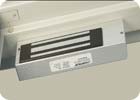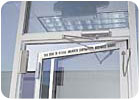Stuck on You

Electromagnetic locks are the rough and tumble end of an access control system.
They are the essential workhorses of electronic door access control systems. Been around forever, they get little respect but they continue to hold on.
Welcome to the magnetic appeal of electromagnetic locks, simple devices which only require the contact of a metal plate, usually at the top of the door, with a plate whose magnetic field is created by electricity to secure the door to its rated force. Sounds so industrial, but these doorplates can dress up -- small, highly polished and stylish, if required. But there’s hell to pay if an intruder thinks he can defeat them. “Anything with a lock is vulnerable to picking, but there is nothing to pick with magnetic locks,” pointed out David Engebretson, president of Slayton Solutions Ltd.
Unlike some other security gear, they are fail-safe – there’s no mechanics involved or mechanical mechanisms that can bind up, stick or jam. Without power, magnetic locks will unlock to allow emergency egress from a facility without any mechanical action needed. Need higher level of security? Just add battery backup for continued access control in case of power failure.
HERCULES IN A DRESS
But what about aesthetics say some chief security officers, whose enterprises more often today want good looks and monster strength. So various magnetic lock models can be used with glass-style doors, since they’re mounted on the frame rather than the door itself and do not require mechanical latching mechanisms in the door.If you want to unlock a door remotely or automatically, there are three choices:
- Electromagnetic or mag lock,
- Electric strike, or
- Other electromechanically operated mechanism, such as an electric lockset.
A door's location can determine what type of lock is needed.
Mag locks, according to some experts, do well for exterior perimeter doors on commercial buildings where they are unlocked during the day but have operational egress devices for use when they are locked. But they’re good for interior doors and where backup power can be part of the design.

Mag locks can, if not look good, blend into glass doors and the aesthetics of the business.
PUTTING ON POUNDS
Another factor is the holding force in pounds, which can range from approximately 500 to 2,000 pounds. The more pounds, the higher security; but a CSO needs to talk with his or her integrator so that the door is also factored in. One manufacturer's approximate rule of thumb is that a 180-pound man can exert 850 pounds of impact force with his shoulder. Still, that door and frame need to be substantial to be able to utilize the locking force that’s available.Regarding holding force, Security Magazine research found that many experts and makers believe a 500-pound to 700-pound lock can handle internal doors used to manage traffic to an internal office, supply room or closet. For exterior doors that need to provide security, such as hollow metal doors or with concrete-filled frames, the recommendation more often is at least 1,000 pounds of holding force.
Of course, mag locks usually install above a door. But if a door closer does not leave enough room for lock installation to the header, the CSO could consider the top of the side jamb, with a warning to check local building codes.
SIDEBAR: Compliance Issues
Those in the know advise CSOs and their systems integrators to make sure electromagnetic locks comply with all Building Hardware Manufacturers Association (BHMA) and American National Standards Institute (ANSI) performance criteria; meets at least minimum UL listings for magnetic locks; and are listed by the California state fire marshal and MEA in New York City, if applicable.Looking for a reprint of this article?
From high-res PDFs to custom plaques, order your copy today!





